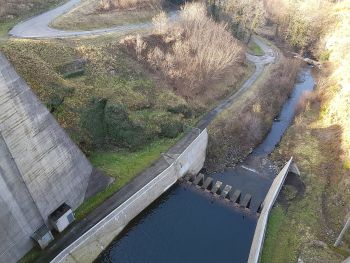Energy Dissipation

|
| See examples of common types of energy dissipators
(Image Source: Luppanox) |
“Terminal structures located immediately downstream of the conveyance feature include stilling basins, energy dissipaters, and flip buckets. These structures are intended to dissipate or manage the kinetic energy of the flow, so it can be returned to the river or stream without significant scour or erosion that could damage or fail the dam and appurtenant structures”.[1]
The high energy and velocity of flow coming down a spillway can be destructive if not adequately contained and dissipated. Flow from a spillway with high velocity can cause erosion at the toe of the dam, and if left unchecked, can destabilize the dam embankment or base of the concrete monolith. High velocity flows can also damage downstream natural channels causing excessive sediment transport and negatively affecting the waterways and tailwater conditions downstream of the dam. High velocity flows can also cause cavitation damage of the spillway or stilling basin components, degrading concrete and steel, and causing structural instabilities.
“The design of the energy dissipator probably includes more options than any other phase of spillway design. The selection of the type and design details of the dissipator is largely dependent upon the pertinent characteristics of the site, the magnitude of energy to be dissipated, and to a lesser extent upon the duration and frequency of spillway use. Good judgement is imperative to assure that all requirements of the particular project are met. Regardless of the type of dissipator selected, any spillway energy dissipator must operate safely at high discharge for extended periods of time without having to be shut down for emergency repairs. An emergency shutdown of the spillway facility during a large flood could cause overtopping of the dam and/or create unacceptable upstream flooding”.[2]
Types of Energy Dissipation
Common types of energy dissipation include the following:
- Headwalls/endwalls
- Impact Basins
- Stilling Basins
- Baffled Chutes
- Stepped Chute Spillways
- Plunge Pools
Examples
![]() See examples and learn more about common types of energy dissipators
See examples and learn more about common types of energy dissipators
Best Practices Resources
![]() Technical Manual: Outlet Works Energy Dissipators, FEMA
Technical Manual: Outlet Works Energy Dissipators, FEMA
![]() Hydraulic Design of Stilling Basins and Energy Dissipators (EM 25), USBR
Hydraulic Design of Stilling Basins and Energy Dissipators (EM 25), USBR
![]() Hydraulic Design of Reservoir Outlet Works (EM 1110-2-1602), USACE
Hydraulic Design of Reservoir Outlet Works (EM 1110-2-1602), USACE
Trainings
![]() On-Demand Webinar: Inlet and Outlet Hydraulics for Spillways and Outlet Structures
On-Demand Webinar: Inlet and Outlet Hydraulics for Spillways and Outlet Structures
![]() On-Demand Webinar: Terminal Structures and Energy Dissipation at Outlet Works and Spillways
On-Demand Webinar: Terminal Structures and Energy Dissipation at Outlet Works and Spillways
Citations:
Revision ID: 8157
Revision Date: 01/22/2025
